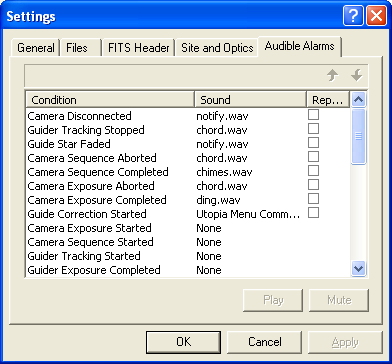

The Audible Alarms tab is used to associate WAV files with various conditions and events. On the occurrence of an event, MaxIm DL will play the associated WAV file through your computer's sound card, alerting you that it has occurred. If you use a different sound for each event that you are concerned about, you can determine what has happened without even looking at the screen. Alarms need not always be used to report problems; by associating a brief, unobtrusive sound with events such as "Camera Exposure Completed" and "Guide Correction Started", you can set up a sort of "MaxIm heartbeat" that assures you everything is working normally.
All possible alarm conditions are shown in the list, but some may not have sound files associated with them. The occurrence of such a condition will not cause an audible alarm.
To configure an alarm, find its Condition in the list and double-click on that row to display a droplist of options. Pick "None" to disable the alarm or "Browse..." to select the desired WAV file for this alarm. Sound files can be in any folder. The most recent sound used with the alarm can be reselected without having to use the file selector.
The position of an alarm in the list indicates its priority relative to the others. Higher priority alarms will preempt those of lower priority, but not vice-versa. You can move an alarm up and down in the list, thus changing its relative priority, by selecting its row then clicking the up or down arrows in the upper right corner of the list control.
An alarm with an unchecked box in the Repeat column is "one-shot": when the associated condition occurs, the sound will play through just once. (This assumes a higher priority alarm is not already playing; if one is, the lower priority sound does not play at all.) Setting the checkbox produces a repeating alarm, one which plays continuously until you click the Mute button. For your convenience, the Settings dialog automatically opens to the Audible Alarms tab when a repeating alarm is triggered.
Unacknowledged repeating alarms are restarted when a higher-priority alarm finishes sounding. "One-shot" alarms of lower priority do not resume after a higher priority interrupting alarm finishes.
You can check how an alarm sounds by selecting it and clicking the Play button. Note that if the specified sound file does not exist, this button is disabled.
After changing alarms in any way, you must click Apply or OK to cause the change to take effect.